HIGHLIGHTS
PROGRAM UPDATES
WoodWorks Sells Out Its First Construction Management Training Workshop The AWC’s Engagement of Fire Services Yields Positive Results Think Wood Mobile Tour Stops at Arkansas Universities Think Wood Launches New and Refreshed Courses for Building ProfessionalsINDUSTRY NEWS
FPL Invents DIY Wood Tornado Shelters Walmart Chooses CLT for New Home Office Adohi Hall Continues to Make Architectural Waves New Open-Access Tool Enables Quick, Accurate Calculations of Embodied Carbon in Building Materials California Firms Consider CLT to Meet New Seismic RegulationsINSIGHTS ON THE COMPETITION
Bill Gates Investing in Low-Carbon Building ConstructionProgram Updates
WoodWorks Sells Out Its First Construction Management Training Workshop
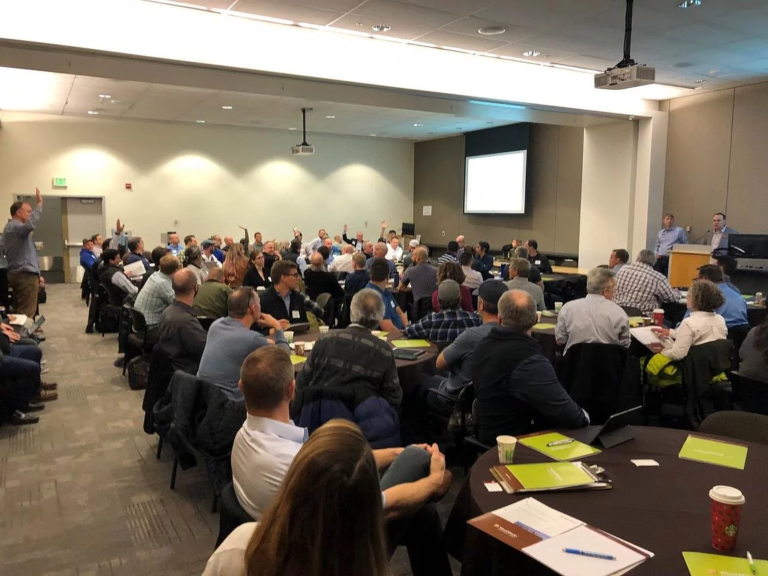
WoodWorks’ Mass Timber Construction Management Training Program got off to an exciting start with its inaugural workshop in Seattle. More than 100 construction professionals spent the day learning about topics such as risk analysis, design team interaction, and cost optimization, all aimed at helping them successfully bid and construct mass timber buildings. Interest in the workshop was so high that WoodWorks had to move it to a larger venue, which also sold out. The workshop has already resulted in two new project conversion leads.
WoodWorks developed the training program after observing that contractors who were unfamiliar with mass timber were adding unnecessary contingency and risk management costs to their bids, making wood products seem less competitive.
WoodWorks will continue to host workshops like these across the country in 2020. For more information, click here.
The AWC’s Engagement of Fire Services Yields Positive Results
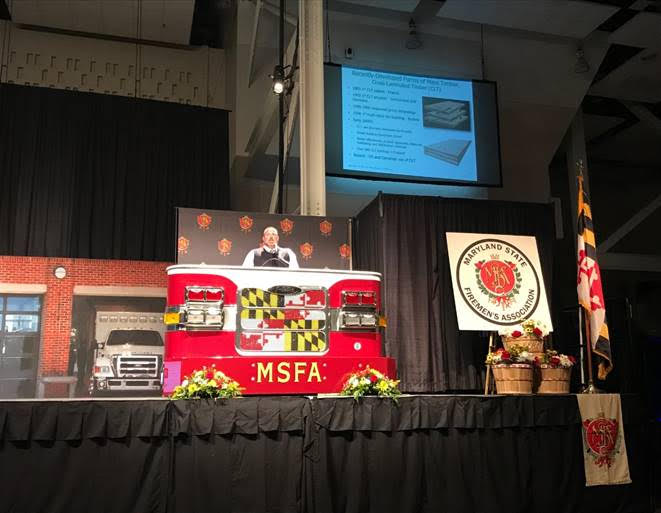
Since its launch two years ago, an American Wood Council (AWC) program to engage fire service personnel in learning more about wood’s fire performance is paying dividends, both through the development of new allies and via a marked decline in the frequency of negative comments about wood following fires in wood buildings. The AWC launched this program in response to the concrete industry’s ongoing efforts to discredit wood-frame construction.
To date, the AWC team—which includes several former fire service leaders—has met with fire service members from 39 states to discuss common goals around fire safety and help members learn more about mass timber innovation and construction; formed a new Fire Service Advisory Council with seven national fire service leaders; and published education articles in targeted fire service magazines as well as the Construction Fire Safety Best Practices guide, which has been presented nationwide.
The AWC is committed to expanding and nurturing strong, open lines of communication between the wood products industry and fire services, and to standing together as trusted partners to address any issues with wood products should they arise.
Think Wood Mobile Tour Stops at Arkansas Universities

Following its launch in Washington, D.C., and a stop in Louisville, Kentucky, the Think Wood Mobile Tour headed to the great state of Arkansas in November for multiday stops at the University of Arkansas’ Fayetteville and Monticello campuses. Think Wood estimates that over 4,000 people visited the exhibit during its stay, including students and faculty from the school’s forestry, architecture, and engineering programs.
Interest and enthusiasm for mass timber were high, with many students gravitating to it as a sustainable solution, including those who currently live in the Fayetteville campus’s Adohi Hall, the nation’s first large-scale mass timber residence hall.
After these successful visits, the Think Wood staff stressed adding as many college and university stops as possible to connect with the next generation of building professionals, particularly in states where the timber industry is currently underutilized.
Keep up to date with the tour’s movement here, or request a tour stop at your industry or education event here.
Think Wood Launches New and Refreshed Courses for Building Professionals

Industry News
FPL Invents DIY Wood Tornado Shelters
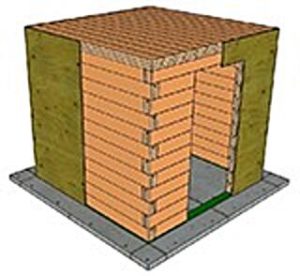
The United States experiences more than 1,000 tornadoes annually, more than any other country worldwide. These storms cause billions of dollars in damage and kill 60 people each year on average.
Researchers at the Forest Products Laboratory (FPL) have developed an 8′x8′ residential tornado shelter made of wood that meets industry safety standards and can be built into an existing home using readily available materials and tools. FPL has partnered with the Home Innovation Research Labs to produce outreach and instructional guides and videos to support homeowners in appropriately siting, designing, and building the shelter.
Access these resource materials and videos here.
Walmart Chooses CLT for New Home Office
Retail giant Walmart has given sustainability priority in its plans for a new Home Office project in Bentonville, Arkansas, which will replace its existing patchwork of offices in more than 20 buildings across the city.
All structures making up the new 350-acre Home Office campus will be designed to create zero waste and operate with 100% renewable energy; many will be built using CLT manufactured in Arkansas. Walmart Executive Vice President Dan Bartlett expects that the campus will become the largest CLT project in the United States.
According to Arkansas Gov. Asa Hutchinson, the project “will drive the economy in terms of the loggers and those that are producing the timber” and through “the preparation of the cross laminated timber. Those are going to be another set of jobs from this.”
The project’s first phase began in summer 2019, and the entire project is scheduled to be completed in 2024.
Adohi Hall Continues to Make Architectural Waves
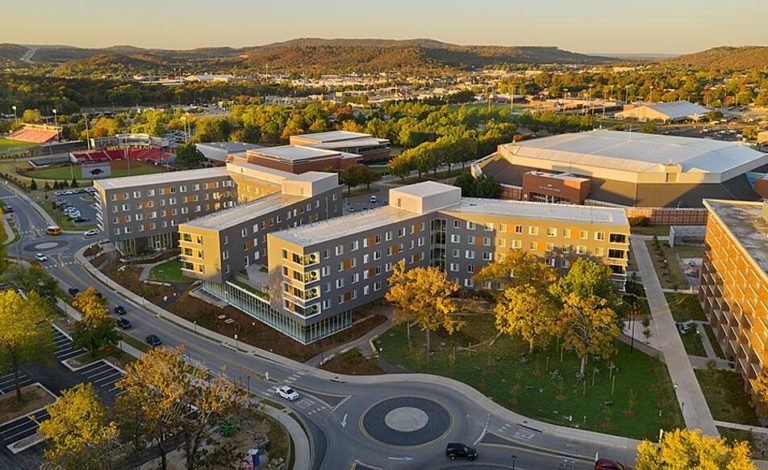
Architectural Record joined the SLB and other media outlets in taking note of the University of Arkansas’ recently opened Adohi Hall. Adohi—named for the Cherokee word meaning “woods”—is a 200,000-square-foot, two-volume-timber complex, covering four acres and with the capacity to house 708 students.
Adohi was designed by Boston-based Leers Weinzapfel Associates in collaboration with Mackey Mitchell Architects, OLIN, and Modus Studio. According to Leers Weinzapfel Associates principal Tom Chung, “The mass timber design reimagines the traditional notion of campus housing as a building on a quad lawn,” instead channeling “a cabin in the woods, where building and landscape are woven together.” The design team specified sustainably sourced European spruce, pine, and fir trees for structural components, and it used local cypress for interior detailing as “an example of a new sustainable way of building our campuses.”
Read more about Adohi Hall here.
New Open-Access Tool Enables Quick, Accurate Calculations of Embodied Carbon in Building Materials
This year’s Greenbuild conference featured the formal launch of the Embodied Carbon in Construction Calculator (EC3), a free, open-access tool designed to empower users to learn how buildings and infrastructure can radically reduce embodied carbon.
Created by the Carbon Leadership Forum with inputs from nearly 50 industry leaders, EC3 allows for supply chain–specific analysis of embodied carbon data, using the first searchable and sortable database of U.S. and Canadian environmental product declarations (EPDs) for concrete, steel, wood, glass, aluminum, insulation, gypsum, carpet, and ceiling tiles. EC3 is also the first tool to create a consolidated, digital EPD form for viewing and analyzing the data. This will allow users to easily estimate upfront embodied carbon emissions associated with material production and construction processes, and make informed decisions to reduce embodied carbon within buildings.
Learn more about the tool here.
California Firms Consider CLT to Meet New Seismic Regulations
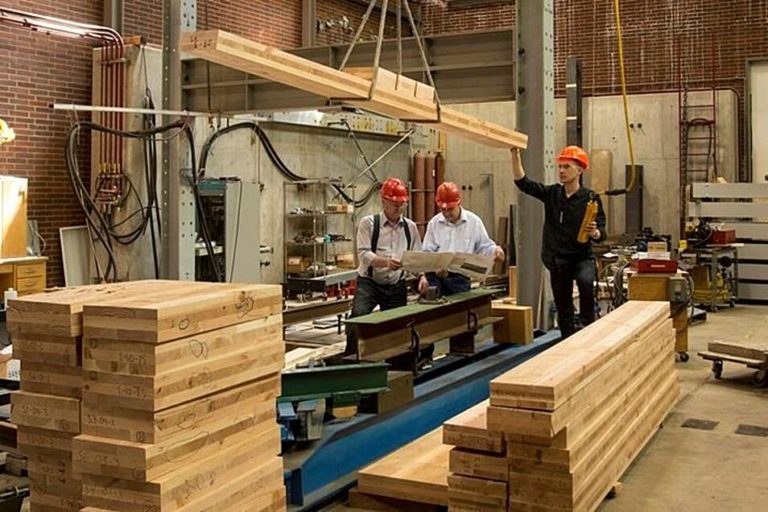
Analysts expect that recent changes to California’s building code relating to seismic requirements will force developers to take a closer and more frequent look at CLT and other lightweight, innovative construction methods. Particularly in light of the Bay Area’s high costs, CLT is a uniquely favorable option, thanks to its shortened construction schedules and reduced labor costs. As such, proponents see an opportunity for CLT to be an asset in increasing the Bay Area’s supply of multifamily housing.
Speaking about the code changes at the Bisnow’s NorCal multifamily conference, DCI Engineers Vice President Jeff Brink said, “For high-rises in the 12- to 24-story range, you could be looking at seismic force increases on the magnitude of 75% or 80% higher than what we’re currently designing for, which translates to a lot of potential added cost to the structure. . . . The best way you can mitigate the seismic impact on your building is to reduce its weight.”
Read more about the California building communities adoption of CLT here.
Insights on the Competition
Bill Gates Investing in Low-Carbon Building Construction

In his most recent Gates Notes blog, Microsoft founder and global philanthropist Bill Gates identifies the building sector as one of five areas where we must innovate if the world is to avoid climate disaster. Gates notes that as the global population rises, urban areas around the world are booming, meaning more and more building construction. By one estimate, the world will add 2 trillion square feet of buildings by 2060—the equivalent of putting up another New York City every month for the next 40 years.
Gates notes that innovations must occur regarding both building construction and operations. Regarding the former, he cites innovations underway at Boston Metal, which is developing a way to make zero-carbon steel using electricity instead of coal, and Carbon Cure, which has developed a method for injecting carbon dioxide into concrete. Gates himself has invested in both companies through Breakthrough Energy Ventures.
Despite its renewable nature and ability to store carbon, mass timber is notably absent as a solution in Gates’ commentary.
Read Gates’ blog post here.
Industry Resources
Virginia Tech’s Monthly Housing Report
This monthly housing commentary report is a free service of Virginia Tech and is intended to help one gauge future business activity in the U.S. housing market.
October 2019 Reports (released in December 2019)
Part A: October Housing Commentary
Part B: October Economic Conditions
Metrostudy Releases Q4 2019 Housing Market Forecast
In Metrostudy’s recent Q4 2019 housing market forecast, chief economist Mark Boud reiterated the prediction that U.S. economic growth will slow over the coming quarters in advance of a recession starting in late 2021/early 2022. Boud expects that the recession will be typified by mild to moderate job losses and reduced consumer spending but stressed that it will not be housing led. Rather, Boud expects that the national housing market will be buffered in part by significant, persisting undersupply.
Currently, high demand for housing and the sector’s inability to meaningfully increase supply because of worker shortages and higher input costs have caused housing prices to increase dramatically, leading to price exclusion and surging demand for rentals. Boud expects that housing prices will only modestly recede during recession.
In addition to the national outlook, the forecast also took a closer look at housing trends and forecasts for Texas metro markets. These markets have benefited enormously from pent-up demand over the last few years.
Listen to Metrostudy’s entire quarterly forecast here.

